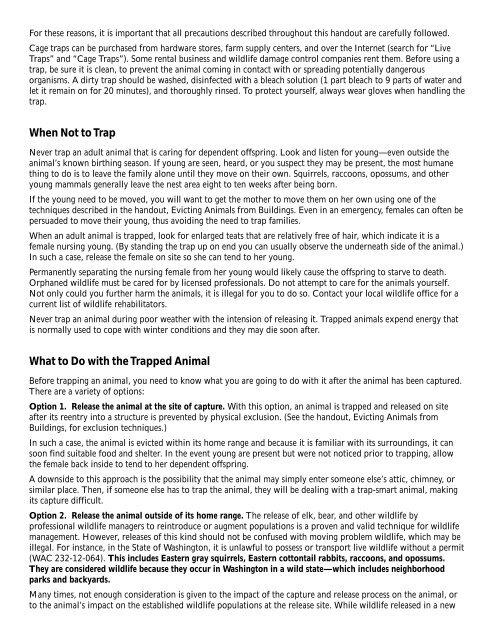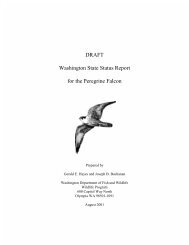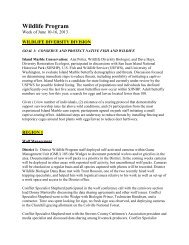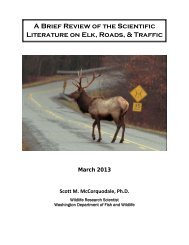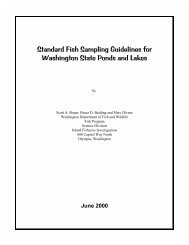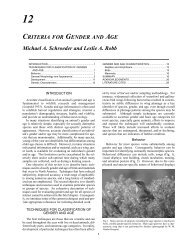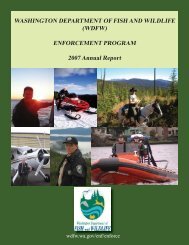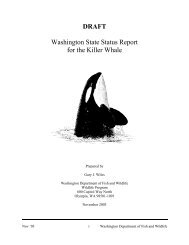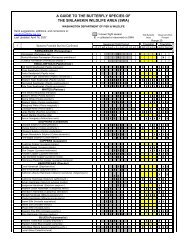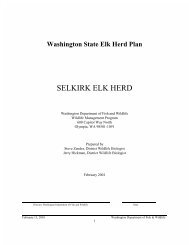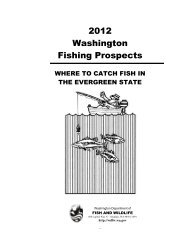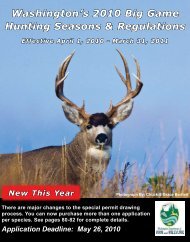Trapping Wildlife - Washington Department of Fish & Wildlife
Trapping Wildlife - Washington Department of Fish & Wildlife
Trapping Wildlife - Washington Department of Fish & Wildlife
You also want an ePaper? Increase the reach of your titles
YUMPU automatically turns print PDFs into web optimized ePapers that Google loves.
For these reasons, it is important that all precautions described throughout this handout are carefully followed.<br />
Cage traps can be purchased from hardware stores, farm supply centers, and over the Internet (search for “Live<br />
Traps” and “Cage Traps”). Some rental business and wildlife damage control companies rent them. Before using a<br />
trap, be sure it is clean, to prevent the animal coming in contact with or spreading potentially dangerous<br />
organisms. A dirty trap should be washed, disinfected with a bleach solution (1 part bleach to 9 parts <strong>of</strong> water and<br />
let it remain on for 20 minutes), and thoroughly rinsed. To protect yourself, always wear gloves when handling the<br />
trap.<br />
When Not to Trap<br />
Never trap an adult animal that is caring for dependent <strong>of</strong>fspring. Look and listen for young—even outside the<br />
animal’s known birthing season. If young are seen, heard, or you suspect they may be present, the most humane<br />
thing to do is to leave the family alone until they move on their own. Squirrels, raccoons, opossums, and other<br />
young mammals generally leave the nest area eight to ten weeks after being born.<br />
If the young need to be moved, you will want to get the mother to move them on her own using one <strong>of</strong> the<br />
techniques described in the handout, Evicting Animals from Buildings. Even in an emergency, females can <strong>of</strong>ten be<br />
persuaded to move their young, thus avoiding the need to trap families.<br />
When an adult animal is trapped, look for enlarged teats that are relatively free <strong>of</strong> hair, which indicate it is a<br />
female nursing young. (By standing the trap up on end you can usually observe the underneath side <strong>of</strong> the animal.)<br />
In such a case, release the female on site so she can tend to her young.<br />
Permanently separating the nursing female from her young would likely cause the <strong>of</strong>fspring to starve to death.<br />
Orphaned wildlife must be cared for by licensed pr<strong>of</strong>essionals. Do not attempt to care for the animals yourself.<br />
Not only could you further harm the animals, it is illegal for you to do so. Contact your local wildlife <strong>of</strong>fice for a<br />
current list <strong>of</strong> wildlife rehabilitators.<br />
Never trap an animal during poor weather with the intension <strong>of</strong> releasing it. Trapped animals expend energy that<br />
is normally used to cope with winter conditions and they may die soon after.<br />
What to Do with the Trapped Animal<br />
Before trapping an animal, you need to know what you are going to do with it after the animal has been captured.<br />
There are a variety <strong>of</strong> options:<br />
Option 1. Release the animal at the site <strong>of</strong> capture. With this option, an animal is trapped and released on site<br />
after its reentry into a structure is prevented by physical exclusion. (See the handout, Evicting Animals from<br />
Buildings, for exclusion techniques.)<br />
In such a case, the animal is evicted within its home range and because it is familiar with its surroundings, it can<br />
soon find suitable food and shelter. In the event young are present but were not noticed prior to trapping, allow<br />
the female back inside to tend to her dependent <strong>of</strong>fspring.<br />
A downside to this approach is the possibility that the animal may simply enter someone else’s attic, chimney, or<br />
similar place. Then, if someone else has to trap the animal, they will be dealing with a trap-smart animal, making<br />
its capture difficult.<br />
Option 2. Release the animal outside <strong>of</strong> its home range. The release <strong>of</strong> elk, bear, and other wildlife by<br />
pr<strong>of</strong>essional wildlife managers to reintroduce or augment populations is a proven and valid technique for wildlife<br />
management. However, releases <strong>of</strong> this kind should not be confused with moving problem wildlife, which may be<br />
illegal. For instance, in the State <strong>of</strong> <strong>Washington</strong>, it is unlawful to possess or transport live wildlife without a permit<br />
(WAC 232-12-064). This includes Eastern gray squirrels, Eastern cottontail rabbits, raccoons, and opossums.<br />
They are considered wildlife because they occur in <strong>Washington</strong> in a wild state—which includes neighborhood<br />
parks and backyards.<br />
Many times, not enough consideration is given to the impact <strong>of</strong> the capture and release process on the animal, or<br />
to the animal’s impact on the established wildlife populations at the release site. While wildlife released in a new


